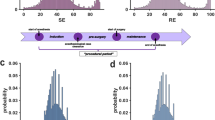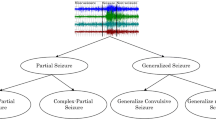Abstract
The blood-brain barrier plays a decisive role in protecting the brain from toxins and pathogens. The ability to analyze the BBB opening (OBBB) is crucial for the treatment of many brain diseases, but it is very difficult to noninvasively monitor OBBB. In this paper we analyze the EEG series of healthy rats in free behaviour and after music-induced OBBB. The research is performed using two completely different methods based on wavelet analysis and machine learning approach. The wavelet-approach demonstrates quantitative changes in the oscillatory structure in EEG signals after music listening, namely, a decrease in the number of patterns to the frequency band \(\varDelta f [1; 2.5] \) Hz. Using methods of machine learning we analyze the number of fragments of EEG realizations recognized as OBBB. After the music impact the number of recognized OBBB is increased in about 50%. Both methods enable us to recognize OBBB and are in a good agreement with each other. The comparative analysis was carried out using F-measures and ROC-curves.







Similar content being viewed by others
References
N. Abbott, Dynamics of cns barriers: evolution, differentiation, and modulation. Cell. Mol. Neurobiol. 25, 5–23 (2005)
N. Abbott, A.A. Patabendige, D.E. Dolman, S. Yusof, D. Begley, Structure and function of the blood-brain barrier. Neurobiol. Dis. 37, 13–25 (2010)
N. Abbott, L. Rönnbäck, L. Hansson, Astrocyte-endothelial interactions at the blood-brain barrier. Nat. Rev. Neurosci. 7, 41–53 (2006)
H. Adeli, Z. Zhou, N. Dadmeh, Analysis of EEG records in an epileptic patient using wavelet transform. J. Neurosci. Methods 123(1), 69–87 (2003). https://doi.org/10.1016/s0165-0270(02)00340-0
U. Albus, Guide for the care and use of laboratory animals (8th edn). Lab. Anim. 46, 267–268 (2012)
A. Aouinet, C. Adnane, Electrocardiogram denoised signal by discrete wavelet transform and continuous wavelet transform. Signal Process. Int. J. 8(1), 1 (2014)
V. Bajaj, R. Pachori, Automatic classification of sleep stages based on the time-frequency image of eeg signals. Comput. Methods Programs Biomed. 112(3), 320–328 (2013)
P. Cavalier, D. O’Hagan, Maximum wavelet coefficient points for potential field analysis and inversion. In: International conference on engineering geophysics, Al Ain, United Arab Emirates, 9-12 October 2017, pp. 128–131. Society of Exploration Geophysicists (2017)
Y. Chassidim, R. Veksler, S. Lublinsky, G. Pell, A. Friedman, I. Shelef, Quantitative imaging assessment of blood-brain barrier permeability in humans. Fluids Barriers CNS 10(1), 9 (2013)
F. Chollet et al. Keras. GitHub (2015). https://github.com/fchollet/keras
C. Davatzikos, K. Ruparel, Y. Fan, D. Shen, M. Acharyya, J. Loughead, R. Gur, D. Langleben, Classifying spatial patterns of brain activity with machine learning methods: application to lie detection. NeuroImage 28(3), 663–668 (2005) https://doi.org/10.1016/j.neuroimage.2005.08.009. http://www.sciencedirect.com/science/article/pii/S1053811905005914
E.C. Djamal, R.D. Putra, Brain-computer interface of focus and motor imagery using wavelet and recurrent neural networks. TELKOMNIKA Telecommun. Comput. Electron. Control 18(4), 2748–2756 (2020)
I. Elbeshlawi, M.S. AbdelBaki, Safety of gadolinium administration in children. Pediatr. Neurol. 86, 27–32 (2018)
B. Everitt, The Cambridge dictionary of statistics (Cambridge University Press, Cambridge, 1998)
T. Fawcett, An introduction to roc analysis. Pattern Recogn. Lett. 27, 861–874 (2006)
Q. Feng, M. Zhang, Y. Zhang, N. Jiang, J. Zhang, Multi-scale representation of sleep electroencephalogram events for healthy adult using wavelet transformation. J. Med. Imaging Health Inf. 7(5), 928–933 (2017)
E. Fernandez-Blanco, D. Rivero, A. Pazos, Eeg signal processing with separable convolutional neural network for automatic scoring of sleeping stage. Neurocomputing 410, 220–228 (2020)
V. Grubov, V. Musatov, V. Maksimenko, A. Pisarchik, A. Runnova, A. Hramov, Development of intelligent system for classification of multiple human brain states corresponding to different real and imaginary movements. Cybern. Phys. 6, 103–107 (2017)
V. Grubov, A. Runnova, M. Zhuravlev, V. Maksimenko, S. Pchelintseva, A. Pisarchik, Perception of multistable images: Eeg studies. Cybern. Phys. 6, 108–113 (2017)
A. Hassan, S. Bashar, M. Bhuiyan, On the classification of sleep states by means of statistical and spectral features from single channel electroencephalogram. In: International conference on advances in computing, communications and informatics (ICACCI), pp. 2238–2243 (2015)
A. Hassan, M. Bhuiyan, Automated identification of sleep states from EEG signals by means of ensemble empirical mode decomposition and random under sampling boosting. Comput. Methods Prog. Biomed. 140, 201–210 (2017). https://doi.org/10.1016/j.cmpb.2016.12.015
I.T. Hettiarachchi, T.T. Nguyen, S. Nahavandi, Motor imagery data classification for bci application using wavelet packet feature extraction. In: International Conference on Neural Information Processing, pp. 519–526. Springer (2014)
A.K. Heye, R.D. Culling, M.C. Valdés Hernández, M.J. Thrippleton, J.M. Wardlaw, Assessment of blood–brain barrier disruption using dynamic contrast-enhanced MRI: a systematic review. NeuroImage Clin 6, 262–274 (2014)
A.E. Hramov, A.A. Koronovskii, V.A. Makarov, A.N. Pavlov, E. Sitnikova, Wavelets in neuroscience (Springer, New York, 2015)
A.E. Hramov, V.A. Maksimenko, S.V. Pchelintseva, A.E. Runnova, V.V. Grubov, V.Y. Musatov, M.O. Zhuravlev, A.A. Koronovskii, A.N. Pisarchik, Classifying the perceptual interpretations of a bistable image using eeg and artificial neural networks. Front. Neurosci. 11, 674 (2017)
Y.L. Hsu, Y.T. Yang, J.S. Wang, C.Y. Hsu, Automatic sleep stage recurrent neural classifier using energy features of eeg signals. Neurocomputing 104, 105–114 (2013)
M. Kaller, J. An, Contrast agent toxicity (StatPearls Publishing, Treasure Island, 2020)
S.K.Khare, V. Bajaj, S. Siuly, G. Sinha, Classification of schizophrenia patients through empirical wavelettransformation using electroencephalogram signals. in Modelling and Analysis of Active Biopotential Signals in Healthcare, (IOP publishing, 2020), pp. 1-1–1-26. https://doi.org/10.1088/978-0-7503-3279-8ch1
J.P. Lachaux et al., Estimating the time-course of coherence between single-trial brain signals: an introduction to wavelet coherence. Neurophysiol. Clin. 32(3), 157–174 (2002)
V.A. Maksimenko, A.E. Runnova, N.S. Frolov, V.V. Makarov, V. Nedaivozov, A.A. Koronovskii, A. Pisarchik, A.E. Hramov, Multiscale neural connectivity during human sensory processing in the brain. Phys. Rev. E 97(5), 052405 (2018)
V.A. Maksimenko, A.E. Runnova, M.O. Zhuravlev, P. Protasov, R. Kulanin, M.V. Khramova, A.N. Pisarchik, A.E. Hramov, Human personality reflects spatio-temporal and time-frequency eeg structure. PloS one 13(9), e0197642 (2018)
L. Montefusco, Wavelets (Elsevier Science, Amsterdam, 2014)
T. Nguyen, A. Khosravi, D. Creighton, S. Nahavandi, Eeg signal classification for bci applications by wavelets and interval type-2 fuzzy logic systems. Expert Syst. Appl. 42(9), 4370–4380 (2015)
A. Ovchinnikov, A. Hramov, A. Luttjehann, A. Koronovskii, G. van Luijtelaar, Method for diagnostics of characteristic patterns of observable time series and its real-time experimental implementation for neurophysiological signals. Tech. Phys. 56(1), 1–7 (2011)
R. Palaniappan, D.P. Mandic, Biometrics from brain electrical activity: A machine learning approach. IEEE Trans. Pattern Anal. Mach. Intell. 29(4), 738–742 (2007)
W. Pan, W. Banks, A. Kastin, Blood-brain barrier permeability to ebiratide and tnf in acute spinal cord injury. Exp. Neurol. 146, 367–373 (1997)
W. Pan, Y. Ding, Y. Yu, H. Ohtaki, T. Nakamachi, A. Kastin, Stroke upregulates tnf alpha transport across the blood-brain barrier. Exp. Neurol. 198, 222–233 (2006)
W. Pan, A. Kastin, R. Bell, R. Olson, Upregulation of tumor necrosis factor a transport across the blood- brain barrier after acute compressive spinal cord injury. J. Neurosci. 19, 3649–3655 (1999)
W. Pan, A. Kastin, L. Gera, J. Stewart, Bradykinin antagonist decreases early disruption of the blood-spinal cord barrier after spinal cord injury in mice. Neurosci. Lett. 307, 25–28 (2001)
A. Pavlov, A. Dubrovsky, A. Koronovskii Jr., O. Pavlova, O. Semyachkina-Glushkovskaya, J. Kurths, Extended detrended fluctuation analysis of sound-induced changes in brain electrical activity. Chaos Soliton Fract. 139, 109989 (2020)
M.A. Perazella, Gadolinium-contrast toxicity in patients with kidney disease: nephrotoxicity and nephrogenic systemic fibrosis. Curr. Drug. Saf. 3, 67–75 (2008)
D.M.W. Powers, Evaluation: From precision, recall and f-factor to roc, informedness, markedness & correlation. J. Mach. Learn. Technol. 2(1), 37–63 (2011)
M. Rogosnitzky, S. Branch, Gadolinium-based contrast agent toxicity: a review of known and proposed mechanisms. Biometals 29(365–376) (2016)
M. Ronzhina, O. Janousek, J. Kolarova, M. Novakova, P. Honzik, I. Provaznik, Sleep scoring using artificial neural networks. Sleep Med. Rev. 16, 251–263 (2012)
G. Rosenberg, Neurological diseases in relation to the blood-brain barrier. J. Cereb. Blood Flow Metab. 32, 1139–1151 (2012)
A.E. Runnova, M.O. Zhuravlev, A.N. Pysarchik, M.V. Khramova, V.V. Grubov, The study of cognitive processes in the brain eeg during the perception of bistable images using wavelet skeleton. In: Dynamics and Fluctuations in Biomedical Photonics XIV, vol. 10063, p. 1006319. International Society for Optics and Photonics (2017)
O. Semyachkina-Glushkovskaya, A. Abdurashitov, A. Dubrovsky, D. Bragin, O. Bragina, N. Shushunova, G. Maslyakova, N. Navolokin, A. Bucharskaya, V. Tuchind et al., Application of optical coherence tomography for in vivo monitoring of the meningeal lymphatic vessels during opening of blood-brain barrier: mechanisms of brain clearing. J. Biomed. Opt. 22(12), 121719 (2017)
O. Semyachkina-Glushkovskaya, A. Esmat, D. Bragin, O. Bragina, A.A. Shirokov, N. Navolokin, Y. Yang, A. Abdurashitov, A. Khorovodov, A. Terskov, M. Klimova, A. Mamedova, I. Fedosov, V. Tuchin, J. Kurths, Phenomenon of music-induced opening of the blood-brain barrier in healthy mice. bioRxiv p. 2020.10.03.324699 (2020). https://doi.org/10.1101/2020.10.03.324699. https://app.dimensions.ai/details/publication/pub.1131448754 and https://www.biorxiv.org/content/biorxiv/early/2020/10/05/2020.10.03.324699.full.pdf
O. Semyachkina-Glushkovskaya, A. Esmat, D. Bragin, O. Bragina, A.A. Shirokov, N. Navolokin, Y. Yang, A. Abdurashitov, A. Khorovodov, A. Terskov, M. Klimova, A. Mamedova, I. Fedosov, V. Tuchin, J. Kurths, Phenomenon of music-induced opening of the blood-brain barrier in healthy mice. Proc. Roy. Soc. B Biol. Sci. 287(1941), 20202337 (2020). https://doi.org/10.1098/rspb.2020.2337. https://royalsocietypublishing.org/doi/abs/10.1098/rspb.2020.2337
A. Subasi, Eeg signal classification using wavelet feature extraction and a mixture of expert mode. Expert Syst. Appl. 32, 1084–1093 (2007)
Z. yao Tian, L. Qian, L. Fang, X. hua Peng, X. hu Zhu, M. Wu, W. zhi Wang, W. han Zhang, B. qi Zhu, M. Wan, X. Hu, J. Shao, Frequency-specific changes of resting brain activity in parkinson’s disease: a machine learning approach. Neuroscience 436, 170–183 (2020). https://doi.org/10.1016/j.neuroscience.2020.01.049. http://www.sciencedirect.com/science/article/pii/S0306452220300798
R. Tripathy, S. Ghosh, P. Gajbhiye, U. Acharya, Development of automated sleep stage classification system using multivariate projection-based fixed boundary empirical wavelet transform and entropy features extracted from multichannel eeg signals. Entropy 22(1141) (2020)
A. Tzallas, M. Tsipouras, D. Fotiadis, Epileptic seizure detection in EEGs using time-frequency analysis. IEEE Trans. Inf. Technol. Biomed. 13(5), 703–710 (2009)
M. Unser, A. Aldroubi, A review of wavelets in biomedical applications. Proc. IEEE 84(4), 626–638 (1996)
C.J. Van Rijsbergen, Information Retrieval (University of Glasgow, Information Retrieval Group, 1979)
J. Wei, T. Chen, C. Li, G. Liu, J. Qiu, D. Wei, Eyes-open and eyes-closed resting states with opposite brain activity in sensorimotor and occipital regions: Multidimensional evidences from machine learning perspective. Front. Human Neurosci. 12, 422 (2018) https://doi.org/10.3389/fnhum.2018.00422. https://www.frontiersin.org/article/10.3389/fnhum.2018.00422
S. Yang, C. Gu, E.T. Mandeville, Y. Dong, E. Esposito, Y. Zhang, G. Yang, Y. Shen, X. Fu, E.H. Lo et al., Anesthesia and surgery impair blood-brain barrier and cognitive function in mice. Front. Immunol. 8, 902 (2017)
G. Zhu, Y. Li, P. Wen, Analysis and classification of sleep stages based on difference visibility graphs from a single-channel eeg signal. IEEE J. Biomed. Health Inf. 18(6), 1813–1821 (2014)
E. Zinchenko, N. Navolokin, A. Shirokov, B. Khlebtsov, A. Dubrovsky, E. Saranceva, A. Abdurashitov, A. Khorovodov, A. Terskov, A. Mamedova et al., Pilot study of transcranial photobiomodulation of lymphatic clearance of beta-amyloid from the mouse brain: breakthrough strategies for non-pharmacologic therapy of alzheimer’s disease. Biomed. Opt. Exp. 10(8), 4003–4017 (2019)
Acknowledgements
This work has been supported by the RF Government Grant No. 075-15-2019-1885 in part of the biological interpretation and machine learning approach. In the part of the development of numeric method of data analysis this work has been supported by the Council for Grants of the President of the Russian Federation for the State Support of Young Russian Scientists (Project No. MD-645.2020.9). The biological experiment has been partially supported by Russian Science Foundation Grant No. 18-75-10033.
Author information
Authors and Affiliations
Corresponding author
Rights and permissions
About this article
Cite this article
Semenova, N., Segreev, K., Slepnev, A. et al. Blood-brain barrier permeability changes: nonlinear analysis of ECoG based on wavelet and machine learning approaches. Eur. Phys. J. Plus 136, 736 (2021). https://doi.org/10.1140/epjp/s13360-021-01715-2
Received:
Accepted:
Published:
DOI: https://doi.org/10.1140/epjp/s13360-021-01715-2




